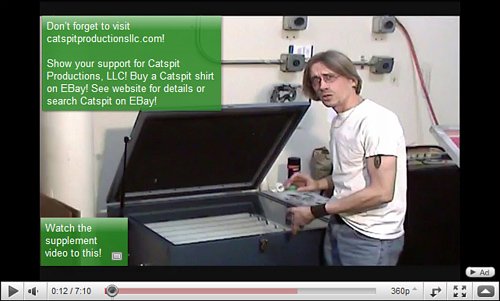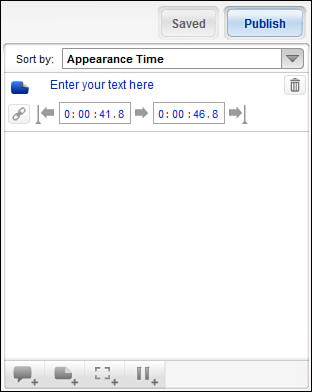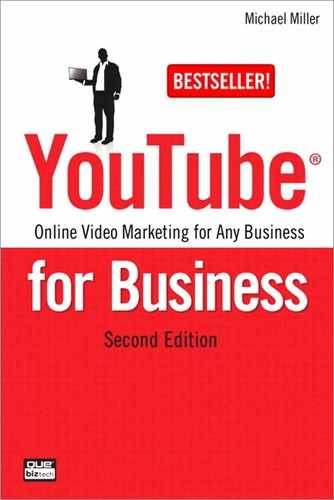14. Annotating and Linking Your Videos
Want to make your video a bit more interactive? Then consider adding annotations to your videos, so that viewers can click on the video to view additional information, links to other videos, and the like.
Understanding Annotations
A YouTube annotation is like an overlay put on top of a normal video. The overlay can be a speech bubble, such as those used on pop-up video programs, or a note containing a link to another YouTube video or user channel. Viewers see your annotations when they click a specific area on the video screen. These overlays can also be used to pause the video playback.
You can add annotations to any video you’ve uploaded. You specify where the annotation appears in the video playback, what area of the screen is clickable, and what happens when that area is clicked.
YouTube lets you add four types of annotations, the first three of which are shown in Figure 14.1:
• Speech bubble, a cartoon-like text box.
• Note, a simple text box.
• Spotlight, a text box that appears only when the user moves his mouse over the overlay area.
• Pause, an area which, when clicked, pauses the video. (There is no text associated with this type of annotation.)
Figure 14.1 A video annotated with a pop-up speech bubble, a note, and a spotlight area.

Note
![]()
Unlike spotlights, both speech bubbles and notes appear automatically at the selected point in the video. No involvement from the viewer is needed.
All three types of annotations can include both text and clickable links. You can link your annotations to other YouTube videos, playlists, channels, groups, and search queries. What you can’t do is link to any pages not on the YouTube site—such as your own web page. You have to satisfy yourself with linking to your other videos or to your channel page.
Note
![]()
If you want to link to your own website, you have to promote the video and add a Call-to-Action Overlay, as discussed in Chapter 23, “Using Call-to-Action Overlays on Your Videos.”
The overlay for the annotation can be any size and placed anywhere on the video window. You can place multiple annotations on screen at the same time or you can use them at different times throughout the video.
Uses for Video Annotations
Annotations are a great way to stuff more information into a YouTube video. How exactly can you use annotations? Here are some ideas:
• Expand on the information presented verbally in the video—give the viewer something to read that provides more depth.
• Detail the steps in a how-to video. Instead of just saying “Step 1, do this,” you can display that text onscreen in an annotation. This makes it easy for the viewer to pause the video and either digest or write down the details in the step. For example, if you’re presenting a cooking how-to, you might list the ingredients for each step in annotations.
• Add interesting but non-essential information, like in those pop-up videos VH1 used to show. Interesting stuff for anyone who cares to click it.
• Link to the next video in a series. If you have a long how-to, for example, you can break it into multiple parts and use annotations to link from one part to another.
• Link to a related video. If you have another video that provides useful background information for the current video, link to it. For example, if you’re annotating a video about changing the oil in a car, you might link to a related video that talks about the different types of motor oil. Figure 14.2 shows just such a supplemental video link, along with an information box, in a video by Catspit Productions (www.youtube.com/user/CatspitProductions/).
Figure 14.2 Two different types of annotations used in a YouTube video.

• Link to your channel page. Why not? Your channel is your home on YouTube, you might as well direct viewers there.
• Display your contact information. You can use an annotation to display your toll-free phone number or the URL for your own web page; just put the contact information right on screen. Know, however, that while you can display your URL, you can’t actually link to it; annotation links are only for pages on the YouTube site.
That’s just a start. I’m sure you can think of other uses for these onscreen annotations. Just be sure not to overdo it; you don’t want to distract viewers with too many pop-up boxes obscuring your video.
Annotating a Video
Adding annotations to any existing video is relatively easy. You start by clicking the down-arrow next to your user name at the top of any YouTube page, then selecting My Videos. When the My Uploaded Videos page appears, click the down arrow next to the video you want to annotate and then select Annotations. This displays the Annotations page for that video, as shown in Figure 14.3.
Figure 14.3 The Annotations page for a YouTube video.

Play or fast forward the video to the point where you want the annotation to begin and then click the Add button for the type of annotation you want to add. You can select from Add Speech Bubble, Add Note, Add Spotlight, or Add Pause Annotation.
The overlay for the annotation now appears onscreen, as shown in Figure 14.4, along with four editing buttons—Change Annotation Type, Add Annotation Link, Change Annotation Color, and Delete. Use your mouse to drag the overlay into the desired position or to resize the overlay as necessary and then enter the desired text into the annotation’s text box.
Figure 14.4 Creating a video annotation.

If you want the annotation to include a clickable link to another video or to your channel page, click the Add Annotation Link button to display the Add Link box, shown in Figure 14.5; pull down the Link Type list and select the type of link; enter the URL for the link into the link box; and then click the Save button.
Figure 14.5 Inserting a link into an annotation.

Tip
![]()
To change the color of the annotation, click the Change Annotation Color button and select a text and background color combination.
To establish the start and stop points for this annotation, drag the right and left positioning cursors (located above the video’s playback slider) into the desired positions, as shown in Figure 14.6. Alternatively, you can enter the precise start and stop times into the panel to the right of the video window, as shown in Figure 14.7.
Figure 14.6 Defining the length of an annotation.

Figure 14.7 Entering precise timing for an annotation.

You can insert multiple annotations into the video, if you like. When you’re done adding annotations, click the Publish button.
Watching an Annotated Video
Watching an annotated video is like watching any YouTube video. At a given point in the video, the annotations will appear onscreen. Spotlight annotations, of course, are visible only when you hover your cursor over that area of the screen. If an annotation contains a link, viewers can click that link to go to the given video or channel.
The Big Picture
Annotations let you display more information onscreen for any YouTube video. You can add note boxes and speech bubbles, and even include links to other YouTube videos or your channel page. It’s easy to add annotations to any existing video—in fact, you can add more than one annotation if you like.
